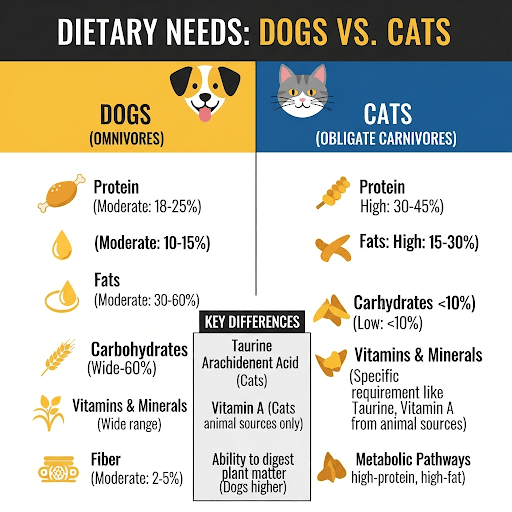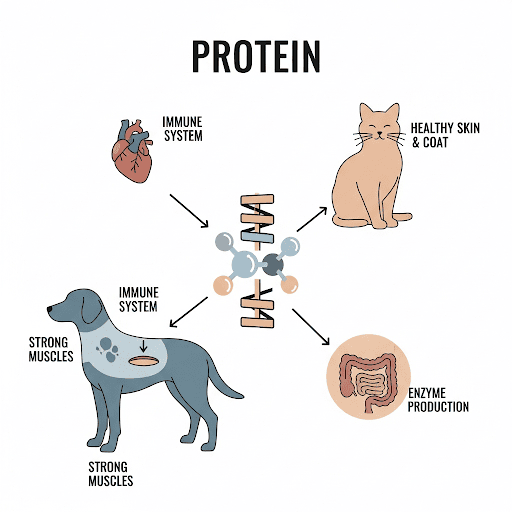If protein provides the building blocks and vitamins act as the spark plugs, then minerals are the very steel frame, wiring, and foundation of your pet’s body. They are the inorganic elements, drawn from the earth itself, that provide unyielding structure and enable the fundamental processes of life.
Like vitamins, the long list of minerals in pet food on an ingredient panel can seem cryptic. We see names like manganese, selenium, and potassium, but what do they actually do? And how do they work? This guide will explore the power of these essential nutrients, breaking down the two major types and explaining why their balance is one of the most critical aspects of your pet's diet.
Macrominerals and Microminerals: The Big Players and the Detail-Oriented Crew
Essential minerals are categorized into two groups, not by importance, but by the quantity required in the diet. Both are absolutely vital for health.
Macrominerals
As the name implies, these are required in larger amounts. They are the primary structural and electrical components of the body.
- Calcium & Phosphorus: This is the most famous mineral duo, working together to form strong bones and teeth. They make up the majority of the mineral content in your pet’s body.
- Potassium, Sodium & Chloride: These are the key electrolytes. They manage the body’s fluid balance, maintain proper pH, and are critical for nerve impulse transmission and muscle function.
- Magnesium: A partner to calcium and phosphorus in bone formation, it’s also essential for hundreds of enzymatic reactions and muscle contraction.
Microminerals (or Trace Minerals)
These are required in much smaller, almost microscopic, amounts, but a deficiency can have catastrophic consequences.
- Iron: The core component of hemoglobin, which carries life-giving oxygen in the red blood cells.
- Zinc: A powerhouse for the skin and coat, zinc is also crucial for wound healing, immune response, and protein synthesis.
- Copper: Necessary for forming red blood cells, connective tissue (like cartilage), and bone. It also helps the body absorb and use iron.
- Selenium: A vital antioxidant that works in partnership with Vitamin E to protect cells from damage.
This team of macrominerals vs microminerals works in concert, and no single one is more important than another.
The Critical Importance of Balance and Ratios
With minerals, balance is everything. It is not enough for a mineral to simply be present in the food; it must be present in the correct proportion to other minerals. An imbalance can be just as dangerous as a deficiency.
The most classic example is the calcium and phosphorus ratio. For strong bones, a pet's diet must contain more calcium than phosphorus, with the ideal ratio being about 1.2 parts calcium to 1 part phosphorus (1.2:1). If there is too much phosphorus, it blocks the body from absorbing calcium. A pet eating a diet with an inverted ratio can suffer from severe bone disease, even if the diet contains what seems like enough calcium. This is one of the most common and dangerous mistakes made in poorly formulated or homemade diets.
This principle applies to other minerals, too—too much zinc can interfere with copper absorption, for example. Achieving this precise mineral balance is a complex nutritional task and a primary reason why feeding a scientifically formulated diet is so important. A pet meal planner app removes the danger of imbalance by using recipes that are pre-formulated to meet AAFCO standards, ensuring the critical ratios are perfectly managed in every meal.
What Are "Chelated" Minerals and Are They Better?
As you read ingredient labels on higher-end pet foods, you may see terms like "zinc proteinate" or "chelated iron." Chelation (pronounced 'key-lay-shun') is the process of chemically bonding a mineral to an organic molecule, like an amino acid.
The primary benefit of this process is improved absorption. By "packaging" the mineral this way, it can be more easily absorbed and utilized by the body. While the presence of chelated minerals is often a hallmark of a high-quality, thoughtfully formulated diet, their absence is not necessarily a red flag. The most important factor is that the food is proven to be "complete and balanced" and meets the essential minerals for pets guidelines set by AAFCO.
(The source of minerals is often listed as 'chicken meal' or 'bone meal.' Learn more about what these terms mean in our article [Understanding Meat Meals (e.g., 'Chicken Meal')].)

Conclusion: The Foundational Strength of a Mineral-Rich Diet
Minerals are the quiet, foundational elements that build your pet from the ground up. They provide the unyielding strength of the skeleton, the electrical current for the nervous system, and the oxygen-carrying capacity of the blood. Their power lies not just in their presence, but in their perfect, delicate harmony.
You don't need a degree in chemistry to provide these essential nutrients. The key is to rely on professionally formulated, "complete and balanced" foods that have done the complex calculations for you. Avoid the risks of imbalance and provide the foundational elements for a strong and healthy body. Speak to your vet about your pet's needs, and see how our meal planner can deliver these powerful minerals in perfect harmony.


